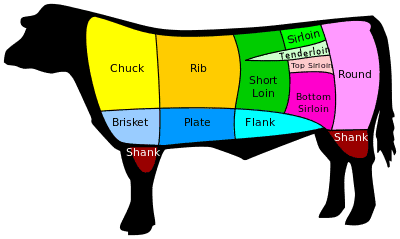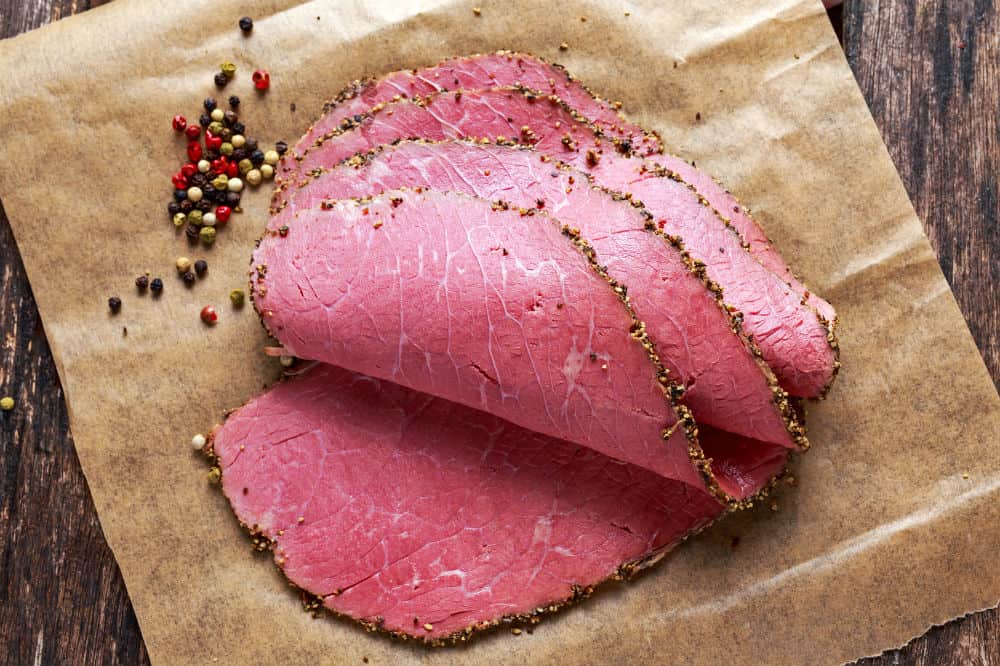This post contains affiliate links. As an Amazon Associate I earn from qualifying purchases
Beef is probably one of the most consumed meats in the world, but even with the commonness, most people are only aware of two or so different meat cuts. There are very many different beef cuts available from which millions of sumptuous recipes can be prepared.
The different cuts feature different flavors and textures depending on which part of the animal they have been extractedfrom. The difference in texture and flavor is what many chefs and beef lovers use to determine the method of preparing the meat whether by grilling, using it as a taco filling or braising.
Table of Contents
Types of Beef Cuts
1. Brisket
This is a beef cut taken from the lower chest and breast of a cow or the veal. You should note that the borders of this cut will vary depending on the individual making the cut and the country you are in.
But generally, briskets include the inner and outer pectoral muscles. Given its location on the animal, these muscles are pretty worked up which makes the brisket cut tougher than most cuts.
This cut is best when it is slow-cooked owing to its toughness. Braising is also highly popular as it allows the meat time to sear and simmer to gain tenderness and reach a flavorful perfection. There are those still who prefer smoking the meat. They start by marinating the meat and then slow cooking the meat over charcoal or wood until it gains fork tenderness.
2. Chuck
The chuck steak is usually rectangular and is found right above the ribs. This cut includes some bit of the shoulder as well. Given the number of intersecting muscles, the chuck steaks tend to be slightly tough.
Also, you may notice different parts of the meat have different grains. Some examples of the chuck steaks include the shoulder top blade, the chuck eye steak, and the shoulder steak.
With this cut, the challenge is always in softening it up to enjoy the perfect balance of meat and fat that comes with the cut.
Ideally, this cut should be marinated before it is cooked. This helps in getting the meat to soften. Braising and boiling as well as grilling are some of the flavorful cooking methods that help to get the tough cut soft and tender.
You should know that this is the cut that is usually used to make ground beef. With that, it goes without saying that the meat is perfect for burgers and meatballs.
3. Flank
This is a beef cut that is flat and long. The cut is from the low sitting abdominal muscles of the animal. The grain of this cut easily sets it apart from the crowd. It contains long and strong like fibers that run through the steak.
This cut is highly flavorful, and many persons love it. But even while that is the case this cut can prove to be tough.
Being a tough cut, slow cooking methods including braising are perfect in helping to soften up this cut. In addition to this, the cut can be grilled.
You should, however, be warned that this cooking method requires you to keep a watchful eye over the cut. This is because the cut easily overcooks when on high heat and may prove to be tricky to lift off the grill.

4. Plate
This cut is also referred to as the short plate. It’s from the front part of a cow’s belly—the part that is just below the rib. From this cut comes different steak types including the hanger steak and skirt steak. Short ribs also are gotten from this cut. This cut is known for its high-fat content and cartilage.
The trick in preparing this cut is in maximizing flavor from the high-fat content and still get to minimize the tough texture of the meat. For this, braising is the best option since it will soften and allow the fats to flavor the entire cut.
5. Rib
This is the most popular cut. Even those who are not lovers of beef know about it. But so that we are on the same page, this cut is taken from the center section of the rib. It is characterized by a tender texture and marbling that is well distributed.
These features make the cut one of the most desired cuts and by far the most expensive on the market. Its tender texture makes it best suited for several different forms of dry heat cooking and will not need any marinating. This tender beef is best served with brown sauce.
6. Shank
From the upper portion of the animal’s leg, this meat portion has a lower fat content and is usually dry because it’s considerably exercised. This cut most often than not is used a component rather than a dish on its own. It is also used to make low-fat ground beef. But in the event you decide to prepare this cut, treat it like you would other tough cuts. Slow cooking and braising are perfect.
7. Short Loin
The short loin is from the cow’s back, often below the ribs and before the rump. The cut often includes the top tenderloin and loin and spine. Cuts from this region include strip steak, Porterhouse and the T-Bone. With excellent flavor and tender texture, the short loin cut is loved by many.
When cooking this cut, you will need to do very little for the flavor to shine through, simple cooking methods (dry heating) are best. However, this cut also affords you room to exercise your creativity.
8. Sirloin
This is the back part of the animal that stretches down to the hind section from where the short loins end. The sirloins are divided into different cuts with the most preferred being the marble top. The bottom sirloin cut is usually bigger but is tougher which causes it to fetch a lower price.
This cut can be prepared in different ways. Given their slightly tender nature, they necessarily do not require to be marinated. They can be grilled, pan-fried, roasted or broiled. It is best served with potatoes on the side.
9. Round Steak
This is extracted from above the shank and below the rump. It is round since it is cut from the leg. You may find the cut with a bone or without.
The bottom round, ‘eye’ round and top round are types of this cut. The cut is moderately tough and lean. The cut has no fat and as such can be prepared via dry heating methods including roasting and grilling.


